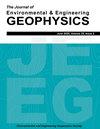地下河探测的地下核磁共振数据处理——以贵州斗模隧道为例
IF 0.7
4区 工程技术
Q4 ENGINEERING, GEOLOGICAL
引用次数: 0
摘要
地下核磁共振(NMR)技术用于隧道、矿山等地下工程的地下水灾害风险检测。然而,在实践中,地下核磁共振往往局限于极低的信噪比(SNRs)。一方面,在狭窄的地下空间中探测水需要使用小线圈,这降低了激发信号的幅度。另一方面,微弱的信号被淹没在由电气装置产生的相当严重的电磁噪声中。低信噪比强调了采用最佳后处理策略获得可靠地下核磁共振数据的重要性。本文以斗莫隧道地下河探测为例,阐述地下核磁共振数据的处理方法。我们对斗模隧道的噪声状况进行了评价,发现该区域的噪声水平为0.6760 nV/m2。在如此高的噪声水平下,难以提取可靠的地下核磁共振信号,无法提供可信的含水率深度剖面。然后,对噪声干扰进行了分析。虽然采用了去尖峰算法和基于参考的降噪方法来去除主要噪声源,但地下核磁共振信号仍然是不可见的。由于仍然存在大量的加性噪声,因此进一步采用时频峰值滤波的方法来抑制剩余的噪声。在地下河的地下核磁共振数据上测试了该后处理策略的性能。结果与地质构造吻合较好,可直接为地下工程的安全预警提供依据。本文章由计算机程序翻译,如有差异,请以英文原文为准。
Processing of Underground Nuclear Magnetic Resonance Data for Underground River Detection: A Case Study in Doumo Tunnel, Guizhou, China
Underground nuclear magnetic resonance (NMR) is introduced to detect the risk of groundwater-induced disasters in the underground engineering such as tunnels and mines. However, underground NMR is in practice often limited to the extremely low signal-to-noise ratios (SNRs). On the one hand, small coils are necessary to be used to detect water in the narrow underground space, which decreases the amplitude of the excited signal. On the other hand, the weak signal is submerged in quite serious electromagnetic noise which is generated from the electrical installations. The low SNRs emphasize the importance of using an optimal post-processing strategy to obtain the reliable underground NMR data. The objective of this paper is to explain the processing of underground NMR data taking the detection of the underground river in Doumo Tunnel as an example. We have evaluated the noise condition in Doumo Tunnel and the noise level of 0.6760 nV/m2 was found in this area. At such a high noise level, the reliable underground NMR signal is difficult to be extracted and the credible depth profile of water content is unable to be provided. Then, we have analyzed the noise interference. Although de-spiking algorithm and reference-based noise cancellation method were applied to remove the major noise sources, the underground NMR signal is still invisible. There is still a lot of additive noise remained, so time-frequency peak filtering method is further used to suppress the remaining noise. The performance of the proposed post-processing strategy is tested on the underground NMR data from the underground river. The result was consistent with the geological structure, which is demonstrated to be able to directly provide a security pre-warning of the underground engineering.
求助全文
通过发布文献求助,成功后即可免费获取论文全文。
去求助
来源期刊

Journal of Environmental and Engineering Geophysics
地学-地球化学与地球物理
CiteScore
2.70
自引率
0.00%
发文量
13
审稿时长
6 months
期刊介绍:
The JEEG (ISSN 1083-1363) is the peer-reviewed journal of the Environmental and Engineering Geophysical Society (EEGS). JEEG welcomes manuscripts on new developments in near-surface geophysics applied to environmental, engineering, and mining issues, as well as novel near-surface geophysics case histories and descriptions of new hardware aimed at the near-surface geophysics community.
 求助内容:
求助内容: 应助结果提醒方式:
应助结果提醒方式:


